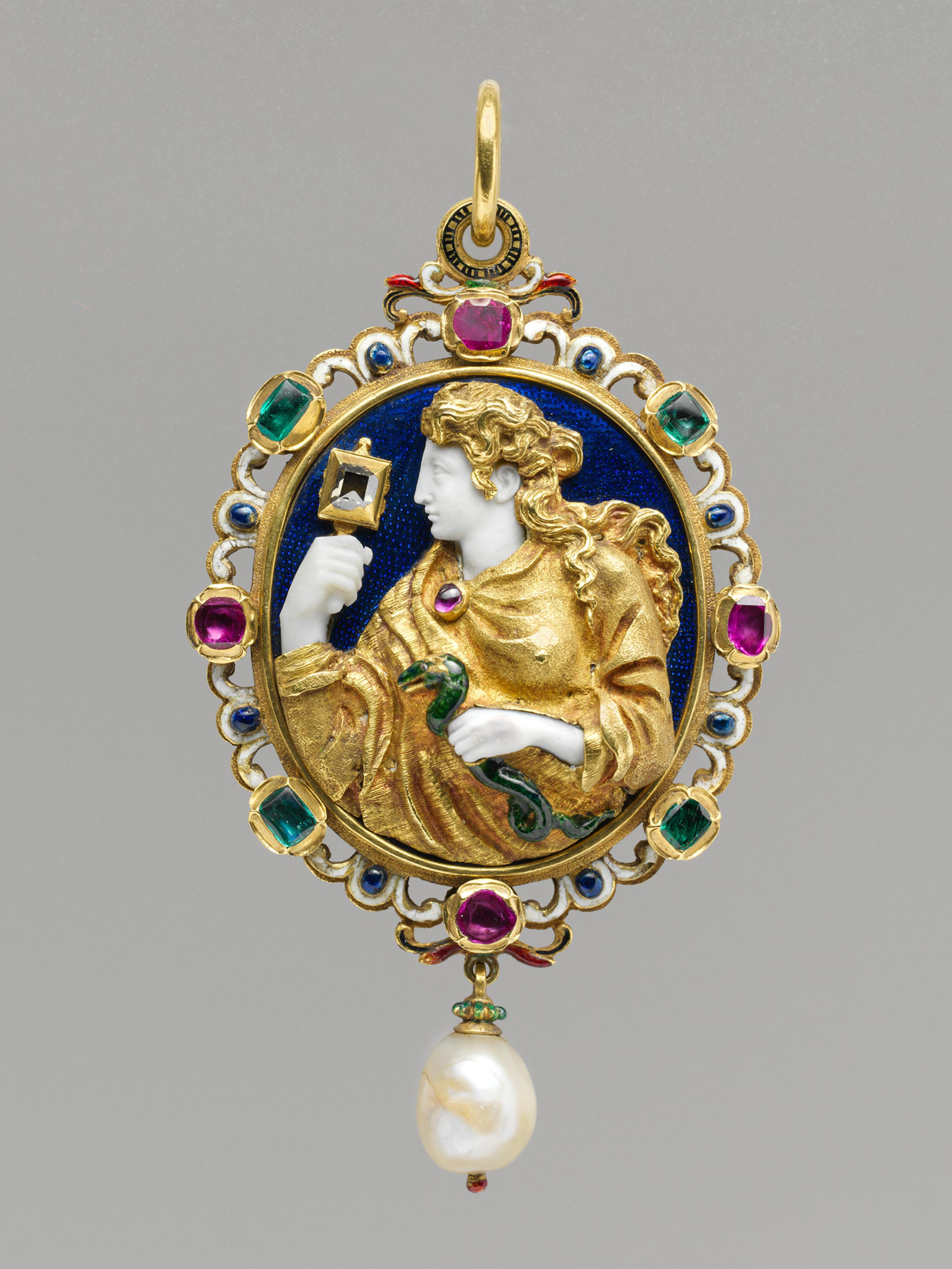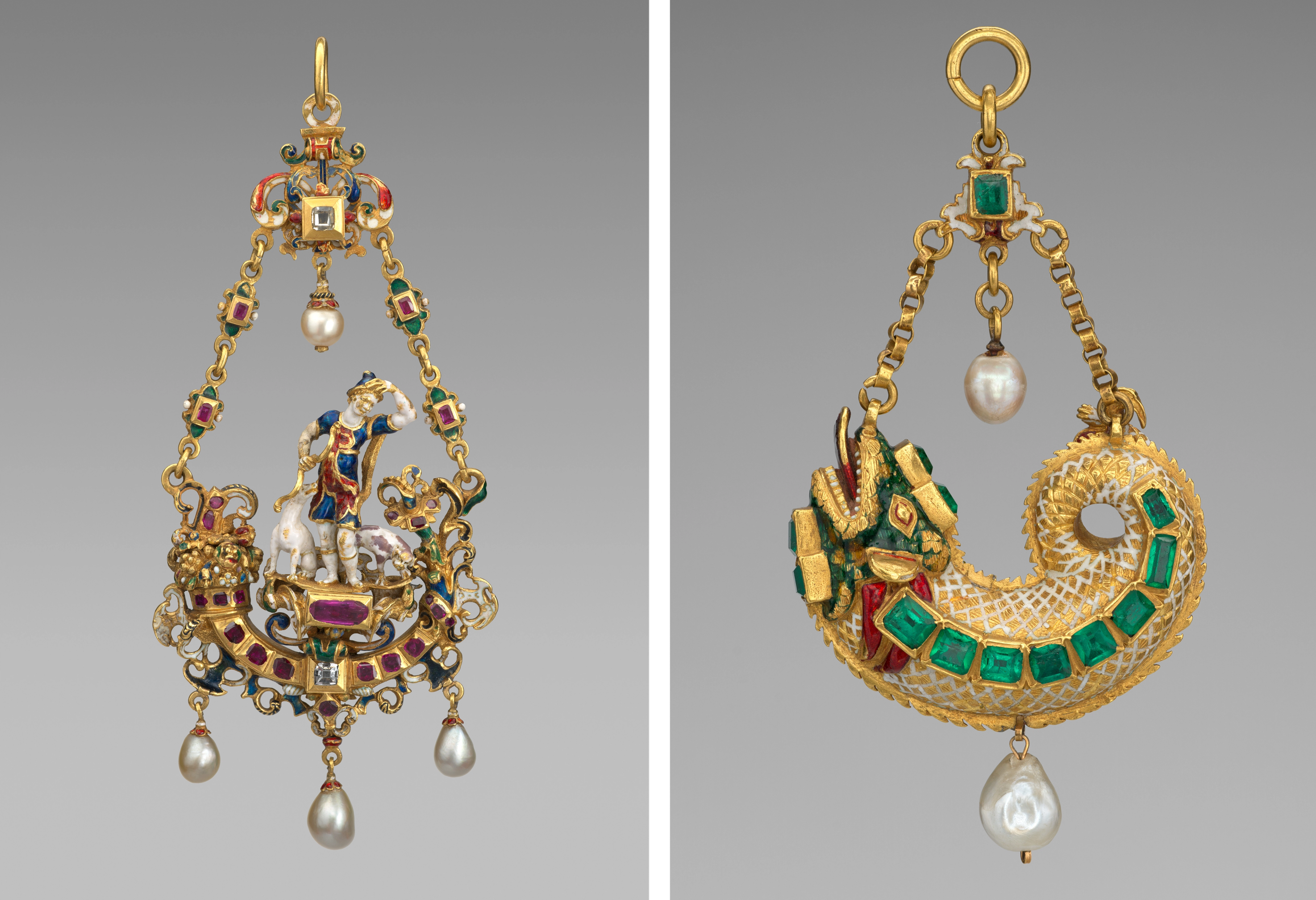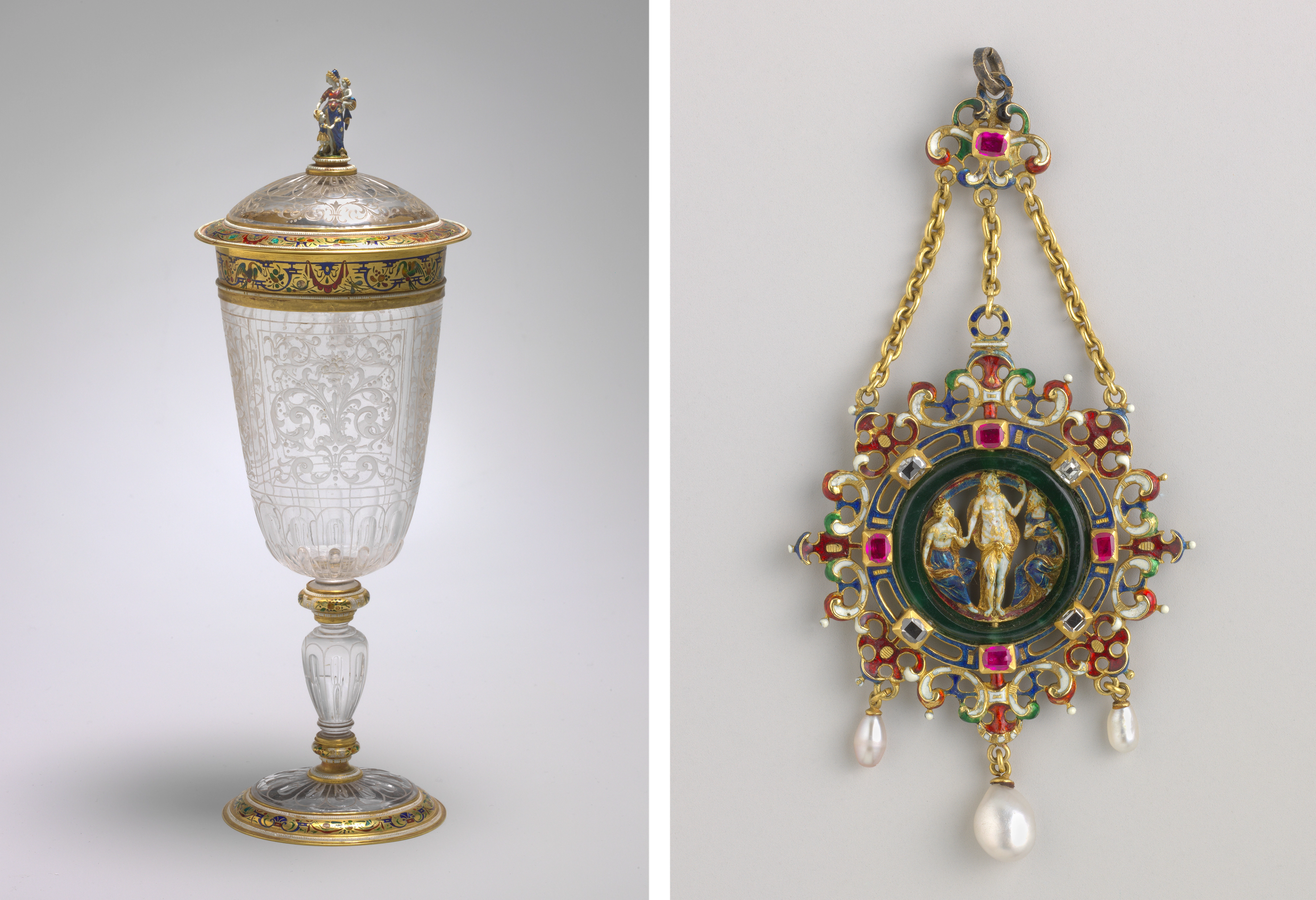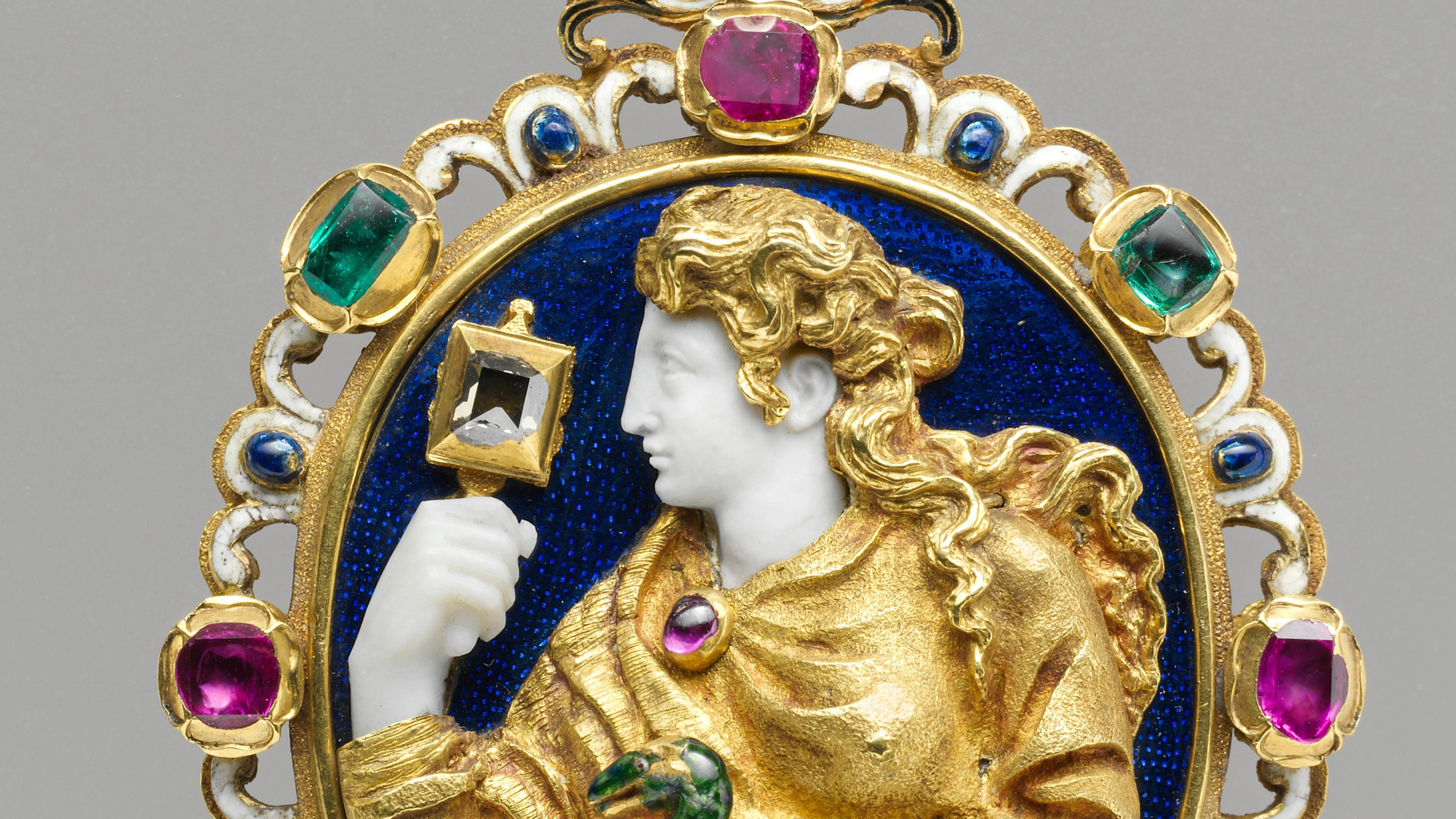In the nineteenth century, a growing demand by collectors for Renaissance jewelry, combined with the limited availability of authentic pieces, encouraged the sale of imitation works by unscrupulous dealers. Recent stylistic re-evaluations as well as emerging documentary evidence have raised questions as to the authenticity of many pieces now found in major collections around the world. Jewelry in the Renaissance usually combined gold, precious stones, and pearls, but was also commonly decorated with colored enamels. As a means of providing objective evidence to help distinguish between authentic Renaissance period pieces and later pieces done in Renaissance style, the enamel compositions from a group of well-dated enameled gold jewelry from the sixteenth and seventeenth centuries, as well as enamels from a group of gold objects from the eighteenth and nineteenth centuries, were chemically analyzed to provide a database to compare the compositions.

Prudence, ca. 1550–60, back: 19th century. France, Paris. Chalcedony, mounted in gold with enamel, rubies, emeralds, diamond, and pearl. The Metropolitan Museum of Art, Gift of J. Pierpont Morgan, 1917 (17.190.907)
Enamels are made from glass which is ground up and applied to a metal substrate, where it is fused in place. Quantitative chemical analyses of the enamel compositions, done with X-ray microanalysis in the scanning electron microscope on very small samples, identified distinct differences in the overall compositions of the Renaissance enamels compared to the later pieces, as well as differences in the colorants (metal ions such as copper and cobalt), and the opacifiers (crystalline inclusions in the glass matrix which serve to inhibit the transmission of light).
Renaissance period translucent enamels can generally be described as having soda-silicate glass compositions, i.e. sodium and silicon based compositions, generally also containing relatively large amounts of potassium, with relatively small amounts of other glass-forming elements such as aluminum, magnesium and calcium. Little if any lead is typically found, although small amounts of lead are often found in red enamels. The red enamels differ somewhat from most of the other colors, generally containing less sodium and more potassium, and may usually be described as having a mixed-alkali compositions (large amounts of both sodium and potassium), rather than being soda-based. Many reds even contain more potassium than sodium, and also generally contain more calcium and magnesium than found in the other translucent enamels.
Unlike the translucent enamels, the opaque Renaissance enamels all contain significant amounts of lead, associated with the opacifer compounds. White crystalline tin oxide is present in the whites, opaque blues and turquoise, while opaque green and the less common opaque yellow enamels contain yellow crystals consisting mainly of lead, antimony and tin.

Left: Pendant, ca. 1600. Possibly German. Gold, enamel, pearls, diamonds, rubies, 4 1/2 x 2 in. (11.4 x 5.1 cm). The Metropolitan Museum of Art, The Friedsam Collection, Bequest of Michael Friedsam, 1931 (32.100.303); Right: Pendant, late 16th–early 17th century. Spanish. Gold, enamel, pearls, emeralds, 3 3/4 × 2 × 7/8 in. (9.5 × 4.9 × 2.2 cm). The Metropolitan Museum of Art, The Lesley and Emma Sheafer Collection, Bequest of Emma A. Sheafer, 1973 (1974.356.655)
The colorants used in the enamels from this period are generally the same metallic oxides used throughout the early history of glassmaking. Very large amounts of colorants, however, were used in the translucent enamels, compared to the amounts usually seen in translucent colored glasses, apparently required to achieve the desired color in very thin translucent layers applied over bright metal. The Renaissance period blue enamels were colored with cobalt, usually associated with iron, nickel, arsenic and bismuth, probably unintentional additions from the cobalt ore used. So-called black enamel is actually a very dark blue or purple-blue in color which appears black in reflected light. These also contain large amounts of cobalt, usually with very large amounts of manganese as well, which produces the purple color. Blue-green enamel was produced by the addition of copper alone, while green enamels were colored by the addition of relatively large amounts of both copper and iron (the iron adds a yellow color which serves to shift the bluish color produced by copper alone towards a more true green color). Red enamel is also colored with copper, as with the greens, but in a red reduced oxide form.
In contrast to enamels from the Renaissance period, those from the eighteenth and nineteenth centuries generally have lead-potash-silicate (consisting mainly of lead, potassium and silicon) or lead-alkali-silicate (i.e. containing relatively large amounts of both sodium and potassium) overall compositions. These enamels also typically contain extremely very low levels of other common glass-forming elements such as magnesium and calcium. Small amounts of arsenic are also commonly present in all colors, while in the earlier enamels arsenic is usually only found associated with cobalt containing enamels.
During the eighteenth century changes also occurred in the colorants and opacifiers used in enamels. While blue enamel continued to be colored by cobalt, as it does to this day, it was not associated with significant amounts of elements like iron, arsenic and bismuth. Apparently by this time cobalt began to be added in a purer form, eliminating the unintentionally added elements coming from the cobalt ore. Another difference is the replacement of copper with antimony as the colorant in the red enamels. During the eighteenth century, tin oxide gradually began to be replaced with a lead arsenic compound as the white opacifier, although examples have been found of opaque enamels from as late as the nineteenth century which contain a mixture of both crystalline tin oxide and lead arsenate. During the nineteenth century green enamel began to be colored with chromium oxide, although they usually contain large amounts of copper as well. Other nineteenth century innovations in enamel compositions include the use of uranium as a yellow colorant, and the beginning of the use of fluoride-based opacifiers.

Left: Reinhold Vasters (German, 1827–1909). Cup with cover, 19th century. Rock crystal, enameled gold, 10 1/2 in. (26.7 cm). The Metropolitan Museum of Art, New York, Bequest of Benjamin Altman, 1913 (14.40.661a, b). Right: Pendant, 16th century, with 19th-century additions. Frame from a design by Reinhold Vasters, German or French. Gold, enamel, green quartz, rubies, diamonds, pearls, 4 × 2 1/8 in. (10.2 × 5.4 cm). The Metropolitan Museum of Art, New York, Gift of George Blumenthal, 1941 (41.100.30)
The findings summarized here reveal definite chemical differences between enamels from the Renaissance and those typical of the eighteenth and nineteenth centuries. However, some evidence has also been found that a few enamelers may have continued to use traditional enamel types well into the nineteenth century. Thus certain compositions discussed here can with a great deal of assurance be described as incompatible with a Renaissance date of production, but the finding of Renaissance-type compositions, while favorable evidence of authenticity, is not absolute proof. To complicate matters even further, the possibility of relatively recent re-enameling of much older objects must be considered for any object found with evidence of modern enamels. Also, very importantly, technical examination of some Renaissance jewelry has revealed a number of objects which have both Renaissance and later type enamels on different parts of the same objects. Many of these objects have recently been condemned on stylistic grounds as being merely later imitations of Renaissance originals. In these cases, however, it appears that some original Renaissance pieces were remounted or had embellishments added during the nineteenth century to form a pastiche of old and new material.
